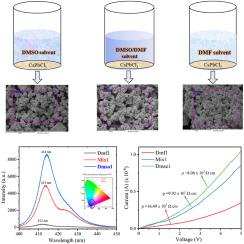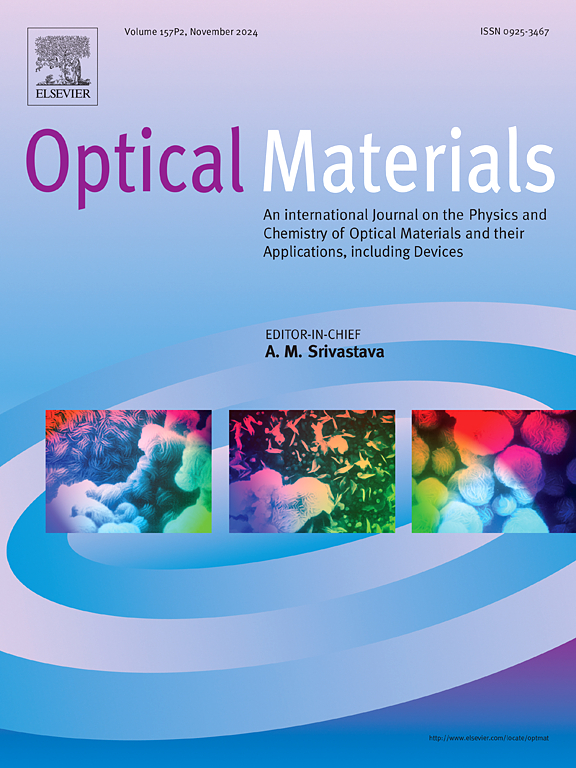利用基于溶剂的合成方法优化 CsPbCl3 包晶石的特性
IF 3.8
3区 材料科学
Q2 MATERIALS SCIENCE, MULTIDISCIPLINARY
引用次数: 0
摘要
全无机卤化物包晶 CsPbX3(X=Cl、Br、I)在光电器件方面显示出令人鼓舞的潜力。本研究采用三种不同的溶剂,即二甲基甲酰胺(DMF)、二甲基亚砜(DMSO)以及二甲基亚砜和二甲基甲酰胺的混合物,通过简单的方法合成了 CsPbCl3 包晶体。通过比较 CsPbCl3 包晶石的结构、光学和电学特性,确定了合成过程中的最佳溶剂。与其他两种氯化锑包晶相比,二甲基亚砜基氯化锑包晶的光带隙值为 2.96 eV,同时还具有高光致发光强度、高电荷载流子迁移率(29.8 cm2/V-s)和低电阻率(8.06 x 107 Ω-cm)。这些结果表明,DMSO 溶剂在实现适用于光电器件的 CsPbCl3 包晶石所需的光学和电学特性方面发挥着重要作用。本文章由计算机程序翻译,如有差异,请以英文原文为准。

Optimizing the properties of CsPbCl3 perovskites using a solvent-based synthesis approach
All-inorganic halide perovskites CsPbX3 (X = Cl, Br, I) have shown encouraging potential for optoelectronic devices. In this work, the synthesis of CsPbCl3 perovskites is reported by a simple approach using three different solvents namely dimethylformamide (DMF), dimethyl sulfoxide (DMSO) and a mixture of dimethyl sulfoxide and dimethylformamide. The structural, optical and electrical properties of CsPbCl3 perovskites are compared to identify the optimal solvent for the synthesis process. The DMSO-based CsPbCl3 perovskite exhibits an optical bandgap value of 2.96 eV along with high photoluminescence intensity, high charge carrier mobility (29.8 cm2/V-s), and low resistivity (8.06 x 107 Ω-cm) compared to the other two CsPbCl3 perovskites. These results indicate that DMSO solvent plays an important role in achieving desired optical and electrical properties of CsPbCl3 perovskites suitable for optoelectronic devices.
求助全文
通过发布文献求助,成功后即可免费获取论文全文。
去求助
来源期刊

Optical Materials
工程技术-材料科学:综合
CiteScore
6.60
自引率
12.80%
发文量
1265
审稿时长
38 days
期刊介绍:
Optical Materials has an open access mirror journal Optical Materials: X, sharing the same aims and scope, editorial team, submission system and rigorous peer review.
The purpose of Optical Materials is to provide a means of communication and technology transfer between researchers who are interested in materials for potential device applications. The journal publishes original papers and review articles on the design, synthesis, characterisation and applications of optical materials.
OPTICAL MATERIALS focuses on:
• Optical Properties of Material Systems;
• The Materials Aspects of Optical Phenomena;
• The Materials Aspects of Devices and Applications.
Authors can submit separate research elements describing their data to Data in Brief and methods to Methods X.
 求助内容:
求助内容: 应助结果提醒方式:
应助结果提醒方式:


